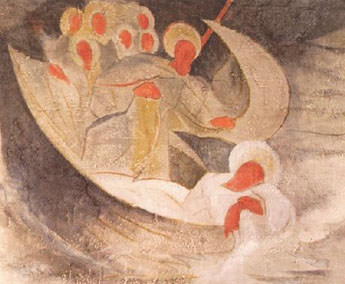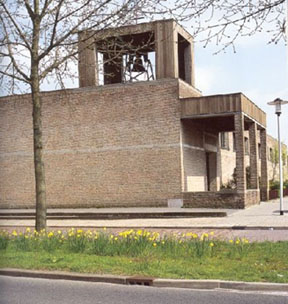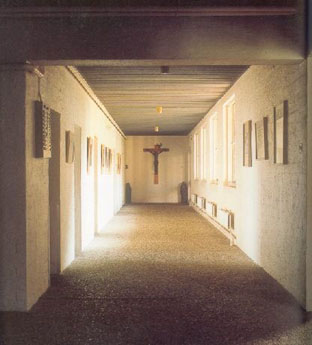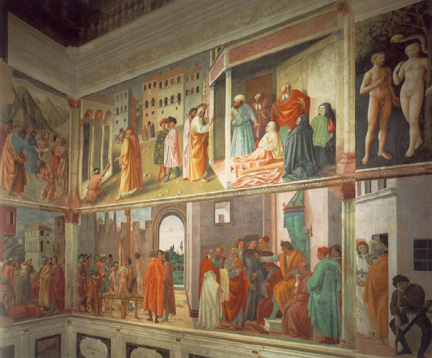|
no. 1 january - march 2006
In the southern part of Almelo, The Netherlands, the Roman Catholic parishes are merging together. There are not sufficient resources nor people to maintain three churches in that part of the town. Willibrordkerk, a Carmelite parish with an adjoining monastery, is one of these churches. Both the church and residence were recently demolished and a valuable example of the so-called Bossche school of architecture was lost. But a book on the architecture of the church and monastery has been recently published. The "Bossche School" is a collective name for a set of ideas about architecture, urban development, furniture, etc., based on the original ideas of the Dutch Benedictine monk Dom Hans van der Laan (1909-1991). His manner of defining ‘architectural space’ was to approach it from a philosophical as well as technological perspective. His basic principle was that the thickness of the wall represents the smallest measurement and that a space is not only determined by the form of the wall, with its length, width and thickness, but also by the proportions between the thickness and distance of each individual wall. Using walls, a "gallery" is created. With galleries, a room comes about. With multiple rooms, a house develops. It is a very austere and sturdy architectural style with an incredible balance between construction and furniture.
For a church that means that the building is a liturgical object and liturgy requires a foundation of general symbols. This foundation is provided by art and especially by the function of beauty. In liturgy all creation, and thus the church building too, are elevated above their usual function.
Before the Carmelite residence and church were destroyed, the murals were carefully removed and are being preserved. It is hoped that they will one day be on exhibition in the Hermitage of St. Petersburg, the birth place of Strawinsky. (from the Dutch Province Bulletin/Translated by Ineke Wackers) Jesus Sleeping During the Storm by Thédore Strawinsky (1907-1989). This is one of the friezes that hung in Willibrordkerk, one of the Carmelite parishes, in Almelo, The Netherlands. The south entrance to the church in Almelo, The Netherlands. A view of a corridor in the Carmelite monastery in Almelo. Before the church and house were torn down, the murals were removed and preserved. Both art and architecture are examples of the the "Bossche School." Carmelite Librarians Focus on International Cooperation Twenty-four participants representing eighteen different libraries belonging to the Carmelite Order met at Les Naudiers conference center in Nantes, France from January 5-7, 2006. The meeting was convoked and chaired by Mark Attard, O. Carm., General Delegate for Culture.This was the fourth meeting of Carmelite librarians over the past six years and for the first time libraries of the Italian, the Upper and Lower German, the Maltese, the Indonesian, the Arago-Valencia, and the Rio Provinces, as well as the Philippine Commisariate were represented along with two new libraries of the British Province. They joined representatives of the libraries of the Most Pure Heart of Mary, the Polish, the Irish, and the Dutch Provinces as well as the libraries of CISA, the French Delegation, and Aylesford. The primary area of discussion centered on international cooperation in the sharing of resources as established libraries offered the newer collections both modern books and digital reproductions of rare sixteenth through eighteenth century publications. A plan for cooperation in acquisitions was also discussed and approved. Approximately fifteen participants remained behind for a three day course for new librarians conducted by Edison Tinanbunam, O. Carm. of the Carmelite Library in Rome, Judith Taylor of the Aylesford Library, and Patricia O’Callaghan of the Washington Collection. The Carmelites of Nantes were gracious in their hospitality and twice entertained the group in their center at Notre Dame de Lumières.
Since the days of St. Benedict, religious orders and communities have been strongly connected to the history of Europe. Each of these communities studies it roots in the European context. Within the Carmelite family, Ambrosius a S. Teresia OCD was the first to survey all OCarm and OCD friaries and monasteries. However his finding have only been published to the letter "P" (Analecta Ordinis Carmelitarum Discalceatorum, Vol. 22 (1950) and Vol. 23 (1951)). In Germany several new projects began after 1990 to describe the significance of cloisters´ on society. The Westfälische Klosterbuch (1992-2003), the Brandenburgische Klosterbuch (started in 2002), the Thüringische Klosterbuch (started in 2002), the Württembergische Klosterbuch (2003) and the Nordrheinische Klosterbuch (started in 2005) are examples of these. With regard to the Carmelites in Belgium, Gerrit van den Bosch, in the service of the State Archives in Brussels, published 2001 the Monasticon van de geschoeide Karmelieten en de geschoeide Karmelietessen in de zuidelijke Nederlanden en het Prinsbisdom Luik. In the Dutch province, Antoine Jacobs is working on a Monasticon Carmelitanum Neerlandicum that will appear in 2007. Thanks to the support of the Carmelite Library at Whitefriars Hall in Washington, DC and its director Patrick McMahon, a large part of the famous Karmeliterbücher, Frankfurt has been digitalized and is now available for further research. In April 2005 the Upper and the Lower German Provinces made the decision to work on a Monasticon Carmelitanum. It will describe all cloisters and monasteries which belong to the present-day area of the Federal Republic of Germany and will be presented in two large parts: Part One includes the foundations of the 13th century until the secularization and will cover 58 cloisters; Part Two includes the foundations of the 19th and the 20th century and will describe 23 cloisters. A particular characteristic of this Monasticon will be the description of the monasteries by the professional archivists who have responsibility for conserving the heritage of these cloisters in their archives today. According to the plan of the editors, Edeltraud Klueting T.O.Carm., Stephan Panzer (GerS) and Andreas Scholten (GerI), the Monasticon will appear in the 2008. A presentation of the project is provided on the web at www.karmelitenorden.de/karmelcms/monasticon/monasticon.html The illustration shows the seal of the Prior of Geldern, the monastery where the female Carmel began with Blessed Johannes Soreth. These books will be very useful to anyone interested in Carmel in Belgium, the Netherlands, and Germany.
Is there or isn’t there "La Sagra" by Masaccio at the Carmine, the Carmelite monastery in Florence, Italy? Several times in the past centuries, efforts have been made to recover Masaccio’s fresco in the cloister, where, soon after 19 April 1422, the date of the solemn consecration of the convent church, he depicts "above the door leading into the church" a "marvellous story" (A. Manetti) "and drew there an infinite number of citizens" (G Vasari). The search started when Giovanni Cinelli, in his book Le Bellezze della Città di Firenze, published in the second half of the seventeenth century, mentioned that the works of transformation of the old cloister in the early years of that century had not destroyed the Sagra but only hidden it "behind a wall". During the several searches of the cloister, which took place as a consequence of this book, all the walls and all the sides were searched, outer walls demolished, plaster removed. Two frescoes came to light, sign that in fact behind the new walls there could be ancient paintings. But the Sagra was never found and, after so many vain attempts, was officially considered to be lost. A Florentine scholar, Divo Savelli, wrote a monograph on the famous fresco of Masaccio and published it in 1998. For the sake of thoroughness, he sought to at least indicate the precise position of the painting and he realised that, precisely because of the changes of the seventeenth century, the first part of the ancient cloister is now a long entrance passage, and because of that it had escaped all the searches made until now. After what was mentioned in ancient sources, these searches had concentrated on the cloister. Clearly, in order to declare that the searches were really concluded, this remaining section of the external side of the church should have been examined. As a result, new preliminary investigations began in 1999 by means of thermography and georadar and in the intervening years, these have yielded very encouraging results so that further steps may be taken on the outside wall to verify the possible survival of traces of the fresco. The scholar has also raised the possibility that the Sagra could have been painted on the spot where it is now being sought because there is a silver plaque of the fifteenth century, attributed to Leon Battista Alberti, who, while depicting an entirely different religious episode, could be the first contextualization of the Sagra, with the front of the Carmelite church on the right and the scenic displays of the square, which, in the front of the building, recall the central scene of the Sagra as it appears in a drawing conserved in the Galleries of the Academy in Venice. It was hoped that something would be found during the 6th centenary of the birth of Masaccio in 2001. The solution to this centuries old puzzle as to the exact location of the Sagra would have been something extra to celebrate. However, the search continues. Variety of Websites Offer Resources Lectio divina on the Internet The gatherings to pray in the lectio divina format that take place every 15 days in the Carmelite parish of Santa Maria in Traspontina are being published on the internet. Santa Maria is located on the Via della Conciliazione, near the Vatican. Carmelite Bruno Secondin, professor at the Pontifical Gregorian University, is the director of this initiative. Lectio divina is a "spiritual reading" of the Sacred Scripture which Pope Benedict XVI recently spoke about during his weekly Angelus address to the crowd in St. Peter's Square. He called this form of prayer one of the very prolific fruits of the Second Vatican Council for every baptized person. The website, http://www.lectiodivina-traspontina.net, publishes a commentary on the biblical passages as well as the meditation music used. There is also information on the books and other initiatives connected with the "lectio divina". The online Carmelite Index contains information about other websites which have lectio divina. This can be found under "L" in the index at carmelites.info. Ingredients: 8 eggs, ½ lemon, 140 g. Sugar, 70 g. Almonds, 53 grams flour Mix 4 egg yolks and 4 entire eggs with the grated peel of half a lemon. Add 140 g. of sugar in layers and whip until dense and thick. Then add the 70 g. of peeled and finely chopped almonds. Also add the 52 g. of flour. Pour everything into a previously buttered mold for round cakes. Bake in the oven for 45 minutes at a moderate temperature. From: Marie Schandrie’s Regensburger Kochbuch für Bürgeliche-und Fastenküche aus dem Jahre 1889. (Book of popular recipies for the Lenten season published in 1889) |
|
RETURN TO THE INDEX FOR 2006 | RETURN TO THE INDEX FOR THIS ISSUE INDEX OF CARMELITE
WEBSITES |


 Jan de Jong (1917-2001) was one of the students of Hans van der Laan.
As an architect and Catholic, he was intimately involved in building the
Carmelite church in Almelo. When the Parish Council approached de Jong
with plans for altering the interior of the church, he wrote a letter of
protest against the changes in which he explained his views on art.
"Architecture creates the typical human habitat in which many other social
activities take place. It transforms the spatial world in which we live
into one that is intellectually meaningful and recognisable by us."
Jan de Jong (1917-2001) was one of the students of Hans van der Laan.
As an architect and Catholic, he was intimately involved in building the
Carmelite church in Almelo. When the Parish Council approached de Jong
with plans for altering the interior of the church, he wrote a letter of
protest against the changes in which he explained his views on art.
"Architecture creates the typical human habitat in which many other social
activities take place. It transforms the spatial world in which we live
into one that is intellectually meaningful and recognisable by us."  In 1968 Thédore Strawinsky (1907-1989) connected his name to a large
undertaking: to produce two friezes, each measuring 1,20 x 36 metres, in
the Willibrordkerk in Almelo. The friezes consist of twenty-four studies
from the life of Christ, twelve on each side of the church. Strawinsky’s
extreme restraint in his use of color makes the friezes appear to be
monochrome. In the center of his palette of color, white stands for the
pure figure of Jesus, black for the satanic, pink for the décor and, in
between, there is yellow ochre. The mural has an extremely lively
character with touches in common with the traditional manner of
expression, but then applied with the artist’s freedom of expression.
In 1968 Thédore Strawinsky (1907-1989) connected his name to a large
undertaking: to produce two friezes, each measuring 1,20 x 36 metres, in
the Willibrordkerk in Almelo. The friezes consist of twenty-four studies
from the life of Christ, twelve on each side of the church. Strawinsky’s
extreme restraint in his use of color makes the friezes appear to be
monochrome. In the center of his palette of color, white stands for the
pure figure of Jesus, black for the satanic, pink for the décor and, in
between, there is yellow ochre. The mural has an extremely lively
character with touches in common with the traditional manner of
expression, but then applied with the artist’s freedom of expression.